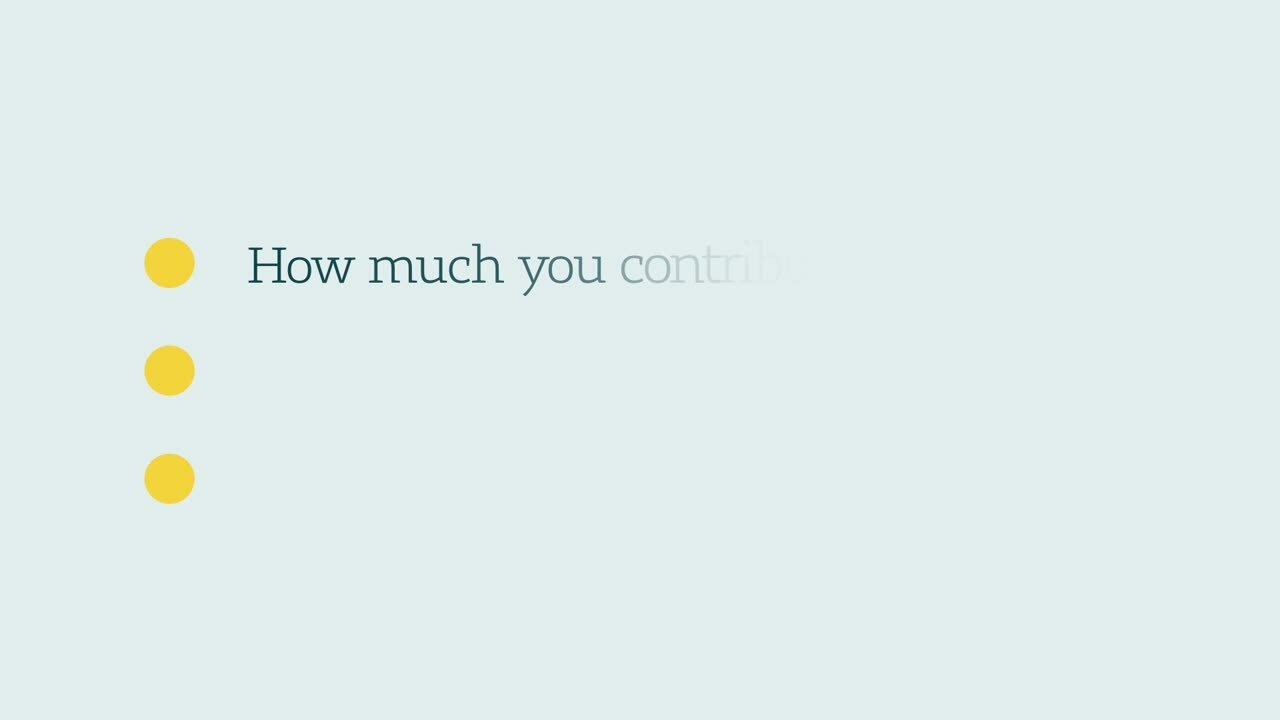Here are 8 actions you can take to get a handle on your finances.
How do employee pension plans work?
What is a workplace pension plan? How can it help you achieve your retirement savings goals? Find out about the two main types of pension plans and the benefits of each.

One of the major financial benefits that Canadians enjoy is workplace pension plans. But what exactly is an employee pension plan? And how can it help you reach your retirement savings goals?
And if you don’t have a workplace pension plan, you can set up your own retirement savings strategy. In all cases, a Sun Life advisor can help you.
What are the two main types of employee pension plans?
There are two main types of employee pension plans:
- defined benefit plans
- defined contribution plans.
What are the two main types of employee pension plans in Canada?
Simply put, if your employer offers a pension plan to help you save for your retirement, it’s likely one of two main types of pension plans:
- A defined benefit pension plan, or
- A defined contribution pension plan.
What is a defined benefit pension plan?
A defined benefit pension plan provides retirement income based on a formula that may include your:
- years of service with your employer,
- salary, and
- age at retirement.
How does a defined benefit pension plan work?
Defined benefit pension plans pool the contributions from both you and your employer in a pension fund. Then, your employer invests the pension fund.
Your employer is responsible for paying your retirement income from the pension fund, based on the plan’s formula.
You’ll receive income each month or year, for the rest of your life. Some defined pension plans are indexed to inflation. That means your income can increase, if the cost of living rises.
What is a defined contribution pension plan?
Defined contribution pension plans provide retirement income, based on the savings you have in the plan. The amount of retirement income you get depends on:
- how much you contribute to the plan,
- how much your employer contributes, and
- how that money grows over time.
How does a defined contribution pension plan work?
There’s no set income level that will be paid. With a defined contribution pension plan, you and your employer pay a defined amount into the plan each year. Companies have mandatory employer contributions, and most have an optional employee component. In most cases, you control how you invest your money. You can usually select investments based on your own risk tolerance and goals. The investment performance determines what your retirement income will be.
What are the benefits of workplace pension plans?
There are many benefits to contributing to your company pension plan:
First, it’s like getting free money. There’s a requirement for employers to contribute to pension plans when they set them up. And, some employers have a matching program. Choosing not to join, or contribute to, your workplace pension plan is like saying no to free money. Remember that in most cases, the money in the pension plan is locked-in for retirement income only.
Second, your contributions are tax-deductible. This means you pay less income tax now. And, contribution and investment earnings are tax-deferred until you withdraw them.
Third, an employee pension plan is a great way to supplement other forms of retirement savings like:
- Canada Pension Plan or Quebec Pension Plan,
- Old Age Security, and
- personal RRSPs and other investments.
Understanding what your pension plan offers can help you make the most of your retirement savings options.
Find more tips and tools at sunlife.ca.
What is a defined benefit pension plan?
This type of plan provides guaranteed retirement income. It is calculated using a formula that takes into account:
- years of service
- salary
How does a defined benefit pension plan work?
This type of plan is funded jointly by the employer and the employees (with some exceptions). Employees contribute via payroll deduction. Employer and employee money is invested in capital market funds. This is what makes up the pension fund. Upon retirement, this fund provides the employee with guaranteed retirement income based on the plan formula.
For example, Michel’s pension is calculated as a percentage of his average salary for the five years prior to retirement and then multiplied by the number of years he was a member of the pension plan.
- Percentage per year of plan membership: 1.5 %
- Average salary: $70,000
- Years of plan membership: 30
- Calculation: 1.5% x 30 x 70,000 dollars
- Annual pension: $31,500
More than 4.4 million Canadians were covered by defined benefit pension plans in 2020 (Source: Statistics Canada).
What is a defined contribution pension plan?
This type of plan provides retirement income based on the amounts members have in their individual accounts. The amount of retirement income you get depends on:
- How much you contribute to the plan
- How much your employer contributed on your behalf
- How that money grows over time.
Unlike the defined benefit pension plan, your pension income is not set in advance. It will depend on how much money is accumulated in retirement.
How does a defined contribution pension plan work?
In such plans, the amount contributed is known (in most cases it is expressed as a percentage of your salary). Contributions come from the employer. Depending on the plan, employees can also contribute. The higher the contributions, the better the retirement income.
In simple terms, it works like a personal bank account. Unlike in the defined benefit plan, employees choose their investments based on their risk tolerance and time horizon.
For example, Claudette has been in a defined contribution plan since she was 40 years old. It invests 4% of her annual salary of $50,000. Her employer contributes the same percentage. Given that her salary has increased by 2% per year and that she has earned a return of 5% per year, her retirement fund will be nearly $250,000 at age 65.
According to Statistics Canada, more than 1.2 million Canadians were covered by a defined contribution pension plan in 2020.
Who manages employee pension plans?
Your employer usually manages the plan with an external partner:
- Investment fund manager
- Insurance company
- Trust
- Consulting services firm
What happens to your pension if you leave your employer?
Your options for what you can do with your pension depend on legislation and the plan.
You may be able to:
- Leave your money in the plan to profit from it at a later date.
- Transfer the value of your pension to another pension plan (if the other plan permits),
- Transfer the funds to a locked-in retirement account (LIRA), which is the equivalent of an RRSP. However, it does not allow for preretirement withdrawals except in certain circumstances. “If the funds are not locked in, which is the case for small amounts, you will be able to transfer such funds to a conventional RRSP,” says Pascale Farez, Regional Director, Client Relations.
- If the funds are not locked in, you can withdraw an amount from the retirement account and pay the applicable taxes. This is generally only possible for small amounts.
- Purchase an annuity from an insurer
If you’re leaving a pension plan for any reason, it may be helpful to talk to a financial advisor. They can walk you through your options. A Sun Life advisor can answer questions and address any concerns you may have.
Are there fees for employee pension plans?
With a defined benefit plan, you don’t pay fees directly. Fees are paid out of the pension fund.
In a defined contribution plan, the management or administration fee is deducted from your assets. In exceptional cases, these fees (in whole or in part) are covered by the employer.
Read more: Are you passing up free retirement savings?
What are the benefits of defined contribution pension plans?
There are many benefits to contributing to your pension plan:
- Lower fees. Your employer negotiates with service providers on behalf of all employees in the plan. This often results in lower fees than you would be able to get on your own.
- Additional contributions. Your retirement does not depend on your contributions alone. Employers contribute to the pension plan when they set it up. Some employers also have a matching program. When an employee contributes a dollar, the employer matches it. Choosing not to join, or contribute to, the plan is like leaving money on the table.
- Tax deductions. Your contributions are tax deductible, so you pay less tax on every paycheque. Plus, contributions and investment earnings are tax-deferred until you withdraw them, just like an RRSP.
- Payroll deduction. Since contributions are usually deducted automatically from your pay, it is easier to save. These regularly deducted amounts eventually add up to provide retirement income. “It easily becomes part of your routine spending,” says Pascale Farez.
- Less emotional investing. You typically can’t withdraw money from a pension plan for reasons other than retirement.* It can help you stay invested for the long-term to make the most of your investments.
*Except as allowed by the plan in specific situations.
Need help figuring out what’s right for you?
An advisor can help put together a solid plan that suits your goals.
This article is meant to provide general information only. Sun Life Assurance Company of Canada does not provide legal, accounting, taxation, or other professional advice. Please seek advice from a qualified professional, including a thorough examination of your specific legal, accounting and tax situation.



